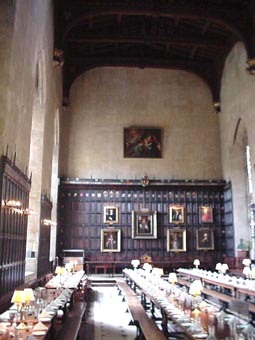
[Editor's note: The story below is more fable than fact, according to New College's own web site.]
If you ask any visitor to Oxford University what is her most vivid impression and she will most likely describe the architecture. The University buildings stand as an exhibit of the evolution of architectural styles from Norman to New Age.
Like other British universities, Oxford is a confederation of colleges. Trinity and Magdelene, St. Anthony's and Christ's, each college has its own physical plant and infrastructure, Dean and Fellows, Customs and Traditions, and each has its own Hall.
The College Hall is used for dining and other gatherings and usually has a vaulted ceiling of timber-frame construction: 18" oak beams, 20 feet in length assembled with interlocking scarf-joints and wooden pegs, The whole is blackened with age and is a stunning example of balance and engineering. Take a look up at the ceiling in Vancouver's Christ Church Cathedral and you'll get a tiny idea of the picture.
Girding for beetle battle
Some years ago a student was clambering around up in the roof beams of New College (so named, presumably, because it was the first college to receive a Charter after a significant interval). He was searching for a specific style of joinery for a paper he was writing - you can tell the age of many Medaeval buildings by the joinery, for in order to be 'raised' into the Company of Master Joiners, a Journeyman would produce a new scarf- or other joint. The acceptance of this literal 'master-piece' would be entered into the rolls of the guild and would serve as the signature of that master builder. As the Guild Rolls still exist, it is fairly straightforward to date a particular building; "This joint was made-patent in May of 1312, therefore it cannot predate that".
I don't know if that particular student found the scarf joint he needed for his thesis, but I do know that he found the roof beams infested with powder-post beetle. These little buggers look like a dark-brown ladybug and are a little larger than the head of a pin. They are also hard to find, hard to kill and can reduce timber of any size to dust. It's not unusual to be completely and blissfully ignorant of their presence until they've rendered your entire house structurally unsound - I MEAN that, I've known houses where the first sign of trouble was when the floor collapsed. If you want to cost me a night's sleep, show me a pinch of fine wood-flour below a pin-hole in the wall.
The student reported his discovery to the Fellows (College Board), and those worthy gentlemen convened a meeting with great consternation. Where would they ever find oak beams of such dimension and quality? How would they ever pay for it once they found it? Would the very College survive this disaster, not to mention the loss of a piece of England's heritage?
Better call the Forester
With great daring a Junior Fellow suggested that, as there was a "College Forester" on the rolls, perhaps it would be wise to seek his counsel? (There are many such seemingly anachronistic positions which are holdovers from the distant past: "Swan-keeper"; "Fletcher" - which is an arrow-maker; one College still lists a "College Champion" from the days when feckless undergraduates might find themselves drawn into a blood-feud or duel, the Champion would fight on their behalf, thus sparing the Dean from having to write an awkward note to the young fools' parents. Some of these postions are inherited, others are extended as a courtesy to benefactors.) So the Forester of New College was summoned to Oxford.
The Forester had not visited the University proper for a long time; he and his staff are responsible for managing the various wooded real-estate to which the College holds title. There is nothing exceptional about Alumni bequests to Colleges and Universities - but Oxford is nearly a thousand years old. An acre here and there really adds up - to the point that Trinity College is the largest single landowner in the Commonwealth after the Sovereign - and some of those acres which were hayfields are now downtown London!
The Fellows of New College put the question to their Forester: Were oak timbers of the required quality and size obtainable and at what cost? And then they waited upon his reply.
"Well, sir, we was wondering when you'd be asking about that...."
It seems that when New College received its Charter in 1379 AD, a grove of oak trees was planted on the first bequested plot of land. These trees were destined to replace the roof beams of (then very) New College Hall when said beams became infested with "beetle", as it was known that oak always falls prey to beetle in the end.
This plan had been passed down from College Forester to College Forester for six hundred years. "You don't cut them oak trees. Them's for the roof of New College Hall!"
The oak trees were felled, milled, and used to replace the infested beams. The field was re-sown with acorns harvested from the felled trees and in several hundred years this process will repeat itself.
Why can't the whole world be run like that?
Robert MacDonald is a Vancouver writer, wooden boat builder, kilt maker and postal worker. He last wrote for The Tyee on Haggis in All Its Glory. ![]()















Tyee Commenting Guidelines
Comments that violate guidelines risk being deleted, and violations may result in a temporary or permanent user ban. Maintain the spirit of good conversation to stay in the discussion.
*Please note The Tyee is not a forum for spreading misinformation about COVID-19, denying its existence or minimizing its risk to public health.
Do:
Do not: